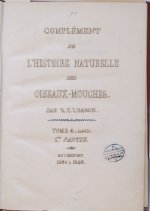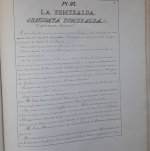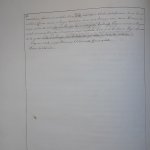Taphrospilus
Well-known member
Ornismya esmeralda Lesson, 1843 OD 1843 pt.2 (1843) - L'Écho du monde savant et l'Hermès - Biodiversity Heritage Library
We can't really talk about a OD.
Therefore we have to come back what I started to discuss here:
In 2018 I had some mail exchange with https://mediatheques.agglo-rochefor...e-fonds-ancien-de-la-mediatheque-de-rochefort
They own the mystere Tome 4 from Lesson which was never published.

To be sure what Lesson may have had in mind it might be required to contact them.
So first I am not sure if it is a valid name and second The Key to Scientific Names - Birds of the World ...
... might be correct but it would help to see the text to plate 2, 3 &4.
We can't really talk about a OD.
La Esmeralda: Ornysmia Esmeralda, Less., 1838
Therefore we have to come back what I started to discuss here:
If HBW key is correct than Trochilus Adolphei Lesson, 1843 OD here is a synonym to Phaethornis ruber nigricinctus Lawrence, 1858 OD here. I am wondering why Lessons name has no priority?
Phaethornis adolphi Gould, 1857 OD here can't be the reason as the plate an text are part of delivery 14 from Gould from the year 1857 or here as Pygmornis Adolphi. Therfore Lesson would have priority. What do I miss?
I think I found the answer myselfe ashere is written:
Would be interesting if this plates and/or the specimen still exist.
In 2018 I had some mail exchange with https://mediatheques.agglo-rochefor...e-fonds-ancien-de-la-mediatheque-de-rochefort
They own the mystere Tome 4 from Lesson which was never published.

To be sure what Lesson may have had in mind it might be required to contact them.
So first I am not sure if it is a valid name and second The Key to Scientific Names - Birds of the World ...
Lesson's 1843, “La Esmeralda”; probably after Esmeralda, the beautiful but tragic heroine of Victor Hugo’s novel (1831) ‘Notre-Dame de Paris / The Hunchback of Notre-Dame’ (syn. Chlorostilbon poortmani).
... might be correct but it would help to see the text to plate 2, 3 &4.







